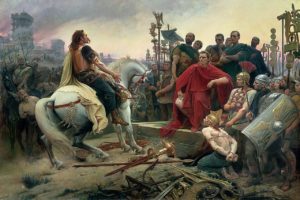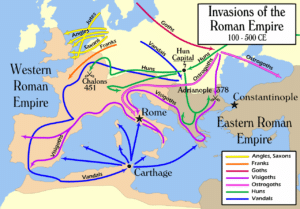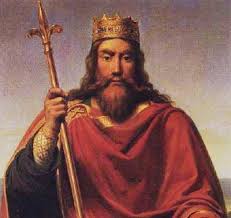Around 125 BC, the south of Gaul was conquered by the Romans, who called this region Provincia Nostra (“Our Province”), which over time evolved into the name Provence in French. Julius Caesar conquered the remainder of Gaul and overcame a revolt carried out by the Gallic chieftain Vercingetorix in 52 BC. According to Plutarch and the writings of scholar Brendan Woods, the Gallic Wars resulted in 800 conquered cities, 300 subdued tribes, one million men sold into slavery, and another three million dead in battle.

Gaul was divided by Augustus into Roman provinces. Many cities were founded during the Gallo-Roman period, including Lugdunum (present-day Lyon), which is considered the capital of the Gauls. These cities were built in traditional Roman style, with a forum, a theater, a circus, an amphitheater and thermal baths. The Gauls mixed with Roman settlers and eventually adopted Roman culture and Roman speech (Latin, from which the French language evolved). The Roman polytheism merged with the Gallic paganism into the same syncretism.
From the 250s to the 280s AD, Roman Gaul suffered a serious crisis with its fortified borders being attacked on several occasions by barbarians. Nevertheless, the situation improved in the first half of the 4th century, which was a period of revival and prosperity for Roman Gaul. In 312, Emperor Constantin I converted to Christianity. Subsequently, Christians, who had been persecuted until then, increased rapidly across the entire Roman Empire. But, from the beginning of the 5th century, the Barbarian Invasions resumed. Teutonic tribes invaded the region from present-day Germany, the Visigoths settling in the southwest, the Burgundians along the Rhine River Valley, and the Franks (from whom the French take their name) in the north.

Early Middle Ages (5th–10th Century):
At the end of the Antiquity period, ancient Gaul was divided into several Germanic kingdoms and a remaining Gallo-Roman territory, known as the Kingdom of Syagrius. Simultaneously, Celtic Britons, fleeing the Anglo-Saxon settlement of Britain, settled the western part of Armorica. As a result, the Armorican peninsula was renamed Brittany, Celtic culture was revived and independent petty kingdoms arose in this region.
The first leader to make himself king of all the Franks was Clovis I, who began his reign in 481, routing the last forces of the Roman governors of the province in 486. Clovis claimed that he would be baptized a Christian in the event of his victory against the Visigoths, which was said to have guaranteed the battle. Clovis regained the southwest from the Visigoths, was baptized in 508, and made himself master of what is now western Germany.

Clovis I was the first Germanic conqueror after the fall of the Roman Empire to convert to Catholic Christianity, rather than Arianism; thus France was given the title “Eldest daughter of the Church” (French: La fille aînée de l’Église) by the papacy, and French kings would be called “the Most Christian Kings of France” (Rex Christianissimus).
